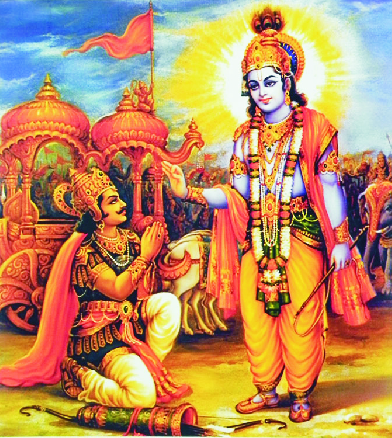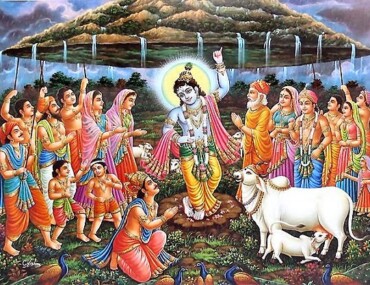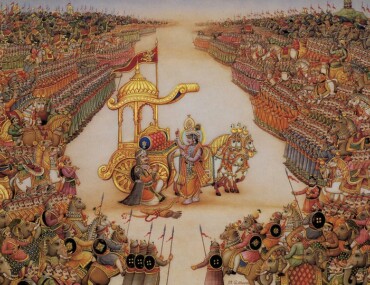In this great work on the importance of the Bhagwad Geeta – “Shrimad Bhagawad Geeta Rahasya or Karmoyoga Shastra “ – Lokmaanya Tilak has said that he wanted to write about the philosophical essence and exact meaning, which has been given in Shrimad Bhagawad Geeta.
Bhagawan Vyasa had written the Mahabharat to narrate life, character and work of the great personalities, ‘Shri Krishna and the Pandava Brothers’. He has included many subsidiary narrations like Nalopkhyaan, Ramopakhyan, and so on. But if he had also discussed the philosophical aspects in every such narration, it would have not been very appropriate, because those topics of philosophy also would have suffered devaluation to that level. Similarly, if as in the Vanaparva or Shantiparva, Geeta was also included then its importance would have been lost in the crowd of such subsidiary narrations.
The purpose of Lokmanya in saying this seems that in Mahabharat, after the conclusion of Udyog parva, when the Mahabharat war is about to start, at such a momentous event the Bhagawad Geeta has been narrated to discuss the Karma and Akarma, in this shastra with weighty arguments and appropriate examples. Not only that, but from the point of view of the overall effect of this great poem, its position in the entire Mahabharat, from every aspect is most appropriate. Mahabharata, such an immense collection of knowledge discussing Dharma – Adharma in detail, a fifth Upveda, without the Geeta, would have remained incomplete!
How and how much can we describe the importance of the Bhagawad Geeta! In the words of Lokmanya, “Shrimad Bhagawad Geeta is the touchstone of the art and science of governance in the Vedic literature. Or else, Geeta is the crest jewel of the Vedic Dharma spreading spiritual light in the society”.
Acharya Vinoba Bhave has also similarly praised the Geeta. He says, in his ‘Talks on the Geeta’ (pg. 9 -10) that Bhagawan Vyasa has placed the Geeta at the highest point in the centre of Mahabharata, so as to spread the light of the lamp of Duty described there on the entire human life.
On one side are six parvas of the Mahabharat and twelve parvas on the other side, Geeta is in the centre. Similarly seven Akshauhinis strong Pandava army on one side and eleven Akshauhinis of the Kaurava Army are arranged on the opposite side. Thus in such a central place the Geeta has been expounded by Shri Krishna to Arjuna. That also shows the importance of the Geeta in Human life.
We have to also note that Mahabharat and Ramayana are our ancient National Literature. The characters therein, have been deeply ingrained in our life. Shri Rama, Sita, Hanuman, Shri Krishna, Bhishma, Dharmaaraj, Draupadi and other characters in Ramayana and Mahabharata, have filled our National Life with enlightenment for several Millennia!
It is to be noted that in other countries their literature does not appear to have been as deeply affecting their people to such an extent. From this viewpoint, Ramayana and Mahabharata are extraordinary books. Further, Ramayana is a lovely song, while Mahabharata is a wider ‘Samaaj Shastra’ – a social philosophy. Shri Vyasa, in a hundred thousand verses, has drawn excellent pictures of innumerable and varied characters. ‘In this world, if there is any character totally free from fault, it is only God; but then on the other hand, there is no one who is totally full of faults.’ – This point is clearly said in the Mahabharata. Here the faults of Bhishma, Yudhishthira have also been shown just as the good points of Karna, Duryodhana are also depicted.
Acharya Vinobaji goes on to say, ‘This means that a man’s life is like a cloth made by a cross weaving in of both white and black threads. Bhagawan Vyasa, keeping himself unattached, shows us a vast canvas of white and dark shaded view of this world. Because of Bhavgawan Vyasa’s totally honest overview of this world, free of any bias, his Mahabharata epic has become a vast Goldmine! One may examine and test any way one likes and carry away the booty! It is a special further question, whether Shri Vyasa had anything of his own to contribute? Where is his special contribution? We are faced with this important question.
As it is, in many places, there are countless philosophical gems, forests of vital discussions in the Mahabharata. But where is the summary crème of secret Jewel? Answer to this is a capital “YES!” It is in the Bhagawad-Geeta, where Bhagawan Vyasa’s main teaching, and his thoughts are elaborated”. Geeta is the depository of entire thought world and teaching of Bhagawan. For the same reason, from ancient times the Geeta has been recognized as an ‘Upanishad’. One can even say that it is the Upanishad of all the Upanishads”. It is clear that every teaching, required for the progress of mankind, is contained in the Geeta. This is why the best thinkers from all times have acclaimed it as the repository of Dharma – Gnyaan. “Knowledge of Dharma, innate duty of every human being.
We find that the Geeta’s main focus is on ‘Vedic Vishwaatma Bhava’ – the feeling of being one with the whole Universe. It is the cream of the Vedic Dharma. What is Vaidic Dharma? It is the clear enunciation of duties of every human being towards mankind and the world around us from vedic times. In all the literature produced in the world so far, Vedas are known to be the oldest; the depository of human knowledge, for the benefit of mankind. It is more precious and valuable compared to all the commandments and teachings carved on stones and brass plates by mighty kings. Even otherwise, the literature of any society is any day more precious, beneficial than their accumulated gold and silver. From this viewpoint, Veda Upanishads are the most precious gift to mankind from the Bharatiya Society!


